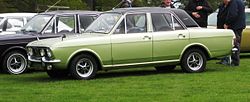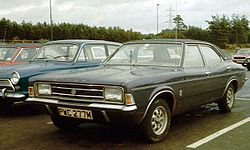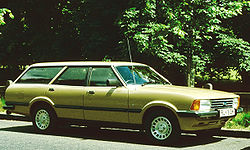- Ford Cortina
-
Ford Cortina 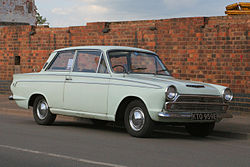
Manufacturer Ford Motor Company
Hyundai Motor CompanyAlso called Ford Consul Cortina Production 1962–1982 Predecessor Ford Consul Classic Successor Ford Sierra
Ford Orion
Hyundai StellarClass Small family car Layout FR layout Related Ford Capri The Ford Cortina is a small family car built by Ford of Britain in various guises from 1962 to 1982.
The Cortina was Ford's mass-market compact car and sold extremely well, making it very common on British roads. It was also Britain's best-selling car of the 1970s. It was eventually replaced in 1982 by the Ford Sierra. In other markets, particularly Asia and Australasia, it was replaced by the Mazda 626-based Ford Telstar, though Ford New Zealand did import British-made CKD kits of the Ford Sierra estate for local assembly from 1984.
The Cortina was produced in five generations (Mark I through to Mark V, although officially the last one was called the Cortina 80) from 1962 until 1982. From 1970 onward, it was almost identical to the German-market Ford Taunus (being built on the same platform) which was originally a different car model. This was part of a Ford attempt to unify its European operations. By 1976, when the revised Taunus was launched, the Cortina was identical. In fact, this new Taunus–Cortina used the doors and some panels from the 1970 Taunus.
All variants of the Cortina sold over one million, with each successive model proving more popular than its predecessor. Such was its fame in the UK that the BBC Two documentary series Arena once devoted an edition to the car and its enthusiasts.[1]
The model's name was inspired by the name of the Italian ski resort Cortina d'Ampezzo, site of the 1956 Winter Olympics. As a publicity stunt, several Cortinas were driven down the bobsled run at the resort which was called Cortina Auto-Bobbing. [2]
Contents
Mark I (1962–1966)
Cortina Mark I 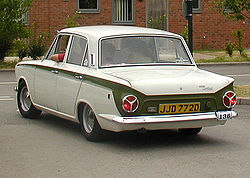
Production 1962-1966
933,143 unitsAssembly Ford Dagenham assembly plant (Dagenham, Essex, England, United Kingdom)
Ford Lio Ho (Chungli City, Taoyuan, Taiwan)
Amsterdam, Netherlands 1962-1975
Campbellfield, Victoria, Australia
Ulsan, South KoreaBody style 2-door saloon
4-door saloon
5-door estate
2-door convertible (conversion)Engine 1.2L OHV "Kent" I4
1.5L OHV "Kent" I4Transmission 3-speed manual
4-speed manual all-symchromesh[3]Wheelbase 98 in (2,489 mm)[4] Length 168.25 in (4,274 mm) (saloon)
168.5 in (4,280 mm) (estate)Width 62.5 in (1,588 mm) Height 56.5 in (1,435 mm) (saloon)
57.75 in (1,467 mm) (estate)Curb weight 1,736 lb (787 kg) (De Luxe)
2,072 lb (940 kg) (Estate)Related Lotus Cortina As the 1960s dawned, BMC were revelling in the success of their new Mini – the first successful true minicar to be built in Britain in the postwar era. Management at Ford of Britain in Dagenham felt that they could not develop a similar small car to the same scale as the production cost would be too high, so instead they set about creating a larger family car which they could sell in large numbers. The result was the Cortina, a distinctively-styled car aimed at buyers of the Morris Oxford and Vauxhall Victor, that was launched on 20 September 1962.[5] Despite its eye catching modern styling, the car was from the start designed to be easy and inexpensive to produce: in Britain the front-wheel drive configuration used by Ford of Germany for their new similarly sized model was rejected in favour of the tried and tested rear-wheel drive layout. The car was branded as the Consul Cortina until a modest facelift in 1964, after which it was sold simply as the Cortina. [6] The car confirmed Ford's reputation for offering a lot of car for the money: the estate version, in particular, provided class-leading load capacity.
The Cortina was available with 1.2 L and 1.5 L four-cylinder engines in two-door and four-door saloon and four-door estate forms. Standard, Deluxe, Super and GT trims were offered but not across all body styles. Estates offered the option of fake wood side and tailgate trim, aping American-style estates, for a short time. There were two main variants of the Mark 1. The Mark 1a possessed elliptical front side-lights, whereas the Mark 1b had a re-designed front grill incorporating the squarer side-lights. A notable variant was the Lotus Cortina.
Advertising of the revised version, which appeared at the London Motor Show in October 1964, made much of the newly introduced "Aeroflow" through-flow ventilation, evidenced by the extractor vents on the rear pillars. A subsequent test on a warm day involving the four different Cortina models manufactured between 1964 and 1979 determined that the air delivery from the simple eye-ball outlets on the 1964 Mark I Cortina was actually greater than that on the Mark II, the Mark III or the Mark IV.[7] The dashboard, instruments and controls were revised, for a the second time, having already been reworked in October 1963 when round instruments replaced the strip speedometer with which the car had been launched:[3] twelve years later, however, the painted steel dashboard, it's "knobs scattered all over the place and its heater controls stuck underneath as a very obvious afterthought" on the 1964 Mark I Cortina was felt to have aged much less well than the car's ventilation system.[7] It was also in 1964 that front disc brakes became standard across the range.[3]
The Cortina was launched a few weeks before the London Motor Show of October 1962 with a 1197 cc 3-bearing engine, which was an enlarged version of the 997 cc engine then fitted in the Ford Anglia.[3] A few months later, in January 1963, the Cortina Super was announced with a 5-bearing 1499 cc engine.[3] Versions of the larger engine found their way into subsequent variations, including the Cortina GT which appeared in Spring 1963 with lowered suspension and engine tuned to give a claimed output of 78 bhp (58 kW; 79 PS) ahead of the 60 bhp (45 kW; 61 PS) claimed for the Cortina 1500 Super. The engines used across the Mark I range were of identical design, differing only in capacity and setup. The formula used was a four-cylinder pushrod (Over Head Valve) design that came to be known as the "pre-crossflow" version as both inlet and exhaust ports were located on the same side of the head. The most powerful version of this engine (used in the GT Cortina) was 1498 cc (1500) and produced 78 bhp (58 kW). This engine contained a different camshaft profile, a different cast of head featuring larger ports, tubular exhaust headers and a Weber double barrel carburettor.
Lotus Cortina models were solely offered as two-door saloons all in white with a contrasting green side flash down each flank. Lotus Cortinas had a unique 1558cc twin cam engine by Lotus, but based on the Cortina's Kent OHV engine. Aluminium was used for some body panels. For a certain time, it also had a unique A-frame rear suspension, but this proved fragile and the model soon reverted to the standard Cortina semi-elliptic rear end.
Mark II (1966–1970)
Cortina Mark II 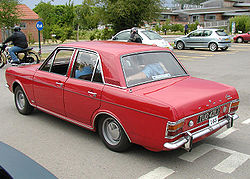
Production 1966-1970
1,159,389 units (UK)Assembly Ford Dagenham assembly plant (Dagenham, Essex, England, United Kingdom)
Ford Lio Ho (Chungli City, Taoyuan, Taiwan)
Amsterdam, Netherlands 1962-1975
Campbellfield, Victoria, Australia
Ulsan, South KoreaBody style 2-door saloon
4-door saloon
5-door estate
2-door convertible (conversion)Engine 1.2L OHV "Kent" I4
1.3L OHV "Kent" I4
1.5L OHV "Kent" I4
1.6L OHV "Kent" I4
3.0L OHV "Essex" V6 (Savage conversion)Transmission 3-speed manual
4-speed manualWheelbase 98 in (2,489 mm)[4] Length 168 in (4,267 mm) (saloon) Width 64.9 in (1,648 mm) Height 55.7 in (1,415 mm) Curb weight 1,890 lb (857 kg) (De Luxe)
2,032 lb (922 kg) (1600E)Designer Roy Haynes The second incarnation of the Cortina was designed by Roy Haynes, and launched on 18 October 1966,[8] four years after the original Cortina. Although the launch was accompanied by the slogan "New Cortina is more Cortina", the car, at precisely 168 inches (427 cm) long, was fractionally shorter than before.[9] Nevertheless, 2½ inches (6 cm) of extra width and curved side panels did give the car a measurable improvement in interior space.[9] In addition to the wider body and track, headline improvements included a smaller turning circle, softer suspension, self adjusting brakes and clutch together with the availability on the smaller-engined models, for the UK and some other markets, of a new five bearing 1300 cc engine.[10]
A stripped-out 1200 cc version running the engine of the Ford Anglia Super was also available for certain markets where the 1300 cc engine attracted a higher rate of tax. The 1500 cc engines were at first carried over, but for 1967, they received a new crossflow cylinder head design, making them more efficient. At this time, they became 1600 cc in size, with the Lotus Cortina continuing with its own unique engine.
Again, a Lotus version was produced (this time done in-house at Ford) but the most admired was the 1600E that came out in late 1967.
The Cortina was Britain's most popular new car in 1967, achieving the goal that Ford had been trying to achieve since it set out to create the original Cortina back in 1960.
Again, two-door and four-door saloons were offered with base, Deluxe, Super, GT and, later, 1600E trims available, but again, not across all body styles and engine options. A few months after the introduction of the saloon versions, a four-door estate was launched, released on the UK market on 15 February 1967:[11] much was made at the time of its class topping load capacity.
The Cortina 1600E, marketed to broaden the Cortina's appeal into a higher market segment, was introduced at the Paris Motor Show in October 1967,[11] a year after the arrived of the Cortina Mark II . It combined the lowered Lotus Cortina's suspension with the high-tune GT 1600 Kent engine and luxury trim featuring a burr walnut woodgrain-trimmed dashboard and door cappings, bucket seating, sports steering wheel and full instrumentation inside, while a black grille, tail panel, front fog lights and plated Rostyle wheels featured outside.
Ford New Zealand developed its own variant of this model called the GTE.
For 1969, the Mark II range was given subtle revisions, with separate "FORD" block letters mounted on the bonnet and boot lids, a blacked out grille and chrome strips on top and below the taillights running the full width of the tail panel marking them out.
A 3.0-litre Essex V6-engined variant was developed privately in South Africa by Basil Green, and was sold through the Grosvenor Ford network of dealers as the Cortina Perana; a similar model appeared later in Britain and was known as the Cortina Savage. Savage was available with 1600E trim in all three body styles, while her South African stablemate was offered only as 4-door saloon initially with GT trim and later E trim.
TC Mark III (1970–1976)
Cortina TC Mark III 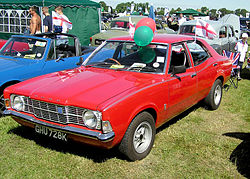
Production 1970-1976
1,126,559 unitsAssembly Ford Dagenham assembly plant (Dagenham, Essex, England, United Kingdom)
Ford Lio Ho (Chungli City, Taoyuan, Taiwan)
Amsterdam, Netherlands 1962-1975
Campbellfield, Victoria, Australia
Ulsan, South KoreaBody style 2-door saloon
4-door saloon
5-door estate
2-door convertible (conversion)
2-door pickup (P100)Engine 1.3L OHV "Kent" I4
1.6L OHV "Kent" I4
1.6L OHC "Pinto" I4
2.0L OHC "Pinto" I4
2.0L OHV "Essex" V4 (South Africa)
2.5 L OHV "Essex" V6 (South Africa)
3.0L OHV "Essex" V6 (South Africa)
3.3L OHV I6 (Australia)
4.1L OHV I6 (Australia)Transmission 4-speed manual
3-speed automatic
3-speed manualWheelbase 101 inches (2578 mm) Length 167.75 inches (4260 mm) (saloon)
171.5 inches (4360 mm) (estate)Width 67 inches (1714 mm) Height 52 inches (1320 mm) In the late 1960s, Ford set about developing a third-generation Cortina, which would be produced in higher volumes than before. It was the last European car engineered by Harley Copp as Vice President Engineering and head of Brentwood, before he returned to Detroit.
The Mark III Detroit-inspired "coke bottle"-shaped Cortina TC was a hit amongst fleet buyers. It replaced both the Cortina Mark II and the larger, more expensive Ford Corsair by offering more trim levels and the option of larger engines than the Mark II.
The MacPherson strut front suspension was replaced with more conventional double A-arm suspension to give the car a soft 'freeway' ride which gave the larger engines distinct understeer.
Ford UK originally wanted to call it something other than Cortina, but the name stuck. Although the Mark III looked significantly larger than the boxier Mark II, it was actually the same overall length, but 4 inches (100 mm) wider.[12] Within the overall length, a wheelbase lengthened by more than 3 inches (76 mm) also contributed to the slightly more spacious interior.[12]
Trim levels were now Base, L (for Luxury), XL (Xtra Luxury), GT (Grand Touring) and GXL (Grand Xtra Luxury). 1.3 L, 1.6 L and 2.0 L engines were offered, the 1.6 L having two distinct types - the Kent unit for models up to GT trim and a SOHC Pinto unit for the GT and GXL, the latter of which was also offered in 1600 form for a short while. 2.0 L variants used a larger version of the 1600 Pinto unit and were available in all trim levels except base.
Although no longer than its predecessor, the Mark III was a heavier car, reflecting a trend towards improving secondary safety by making car bodies more substantial.[12] Weight was also increased by the stout cross-member incorporated into the new simplified front suspension set-up,[13] and by the inclusion of far more sound deadening material which insulated the cabin from engine and exhaust noise, making the car usefully quieter than its predecessor, though on many cars the benefit was diminished by high levels of wind noise apparently resulting from poor door fit around the windows.[12] Four speed manual transmissions were by now almost universally offered in the UK for this class of car, and contemporary road tests commented on the rather large gap between second and third gear, and the resulting temptation to slip the clutch when accelerating through the gears in the smaller-engined cars:[12] it was presumably in tacit acknowledgment of the car's marginal power-to-weight ratio that Ford no longer offered the automatic transmission option with the smallest 1298 cc-engined Cortina.[12]
Four headlights and Rostyle wheels marked out the GT and GXL versions, while the GXL also had bodyside rubstrips, a vinyl roof and a brushed metal and black tail panel on the GXL and plain black one on the GT. All models featured a downward sloping dashboard with deeply recessed dials and all coil suspension all round. In general styling and technical make up, many observed that the Mark III aped the Vauxhall Victor FD of 1967.
The Cortina went on sale on 23 October 1970,[14] but sales got off to a particularly slow start because of production difficulties that culminated with a ten-week strike at Ford's plant between April and June 1971, which was at the time reported to have cost production of 100,000 vehicles, equivalent to almost a quarter of the output for a full year.[15]
During 1971 the spring rates and damper settings were altered along with the front suspension bushes which reduced the bounciness of the ride and low speed ride harshness which had generated press criticism at the time of the Cortina III's launch.[12]
Volumes recovered, and with the aging Austin/Morris 1100/1300 now losing out to various newer models, the Cortina was Britain's top selling car in 1972, closely followed by the Escort.[16]
In late 1973 following a facelift, the Cortina was redesignated TD. Outside, there were revised grilles, rectangular headlights for the XL, GT and the new 2000E (the "E" standing for executive), which replaced the GXL. The 1.3 L Kent engine was carried over but now, 1.6 L models all used the more modern 1.6 L SOHC engine. Whilst the TD Cortina still had double A-arm suspension with coils at the front and a four-link system at the rear, handling was improved. Inside, the car received a neater dashboard that no longer sloped away from the driver's line of sight and upgraded trim. The 2000E reverted to the classy treatment offered by the 1600E and later Ghia models instead of the faux wood-grain trim offered by the GXL.
Like many other Cortinas, Mk.3s were prone to rust and as a result only about 1000 now survive. Because of their rarity and the fact that they are now seen as an iconic car of the mid-70s, prices for MK.3s are rising steadily, with the best examples fetching several thousand pounds.
The Mark III was never sold in the US, although it was available in Canada until 1973.
In addition to four-cylinder models, the Mark III was available in South Africa as the 'Big Six' L and GL with the Essex V6 2.5L engine and Perana (very rare), GT and XLE with the Essex V6 3.0L engine. There was also a pickup truck version available.
Ford Australia built its own versions using both the UK four-cylinder engines (1.6 and 2.0) and locally-made inline six-cylinder engines from its Falcon line.
For Japan, the cars were literally narrowed by a few millimetres on arrival in the country in order that they fit into a lower tax bracket – this was done by bending the wheel arches inwards.
Mark IV (1976–1979)
Cortina Mark IV 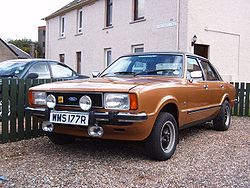
Production 1976-1979
1,131,850 units (including Mk V)Assembly Ford Dagenham assembly plant (Dagenham, Essex, England, United Kingdom)
Ford Lio Ho (Chungli City, Taoyuan, Taiwan)
Campbellfield, Victoria, Australia
Ulsan, South KoreaBody style 2-door saloon
4-door saloon
5-door estate
2-door convertible (conversion)
2-door pickup (P100)Engine 1.3L OHV "Kent" I4
1.6L OHV "Kent" I4 (South Africa)
1.6L OHC "Pinto" I4
2.0L OHC "Pinto" I4
2.0L OHV "Cologne" V6
2.3L OHV "Cologne" V6
3.0L OHV "Essex" V6 (South Africa)
3.3L OHV I6 (Australia)
4.1L OHV I6 (Australia)Transmission 4-speed manual
3-speed automatic
3-speed manualDesigner Uwe Bahnsen The fourth-generation Cortina was a more conventional design than its predecessor, but this was largely appreciated by fleet buyers. Generally a rebody of the Mark III, as an integration of Ford's model range, this car was really a rebadged Ford Taunus. However, although the updated Taunus was introduced to Continental Europe in January 1976, Ford were able to continue selling the Cortina Mark III in undiminished numbers in the UK until they were ready to launch its successor as the Dagenham built Cortina Mark IV, which went on sale on 29 September 1976.[17]
Many parts were carried over, most notably the running gear. The raised driving position and the new instrument panel had, along with some of the suspension upgrades, already been introduced to the Cortina Mark III in 1975, so that from the driving position the new car looked much more familiar to owners of recent existing Cortinas than from the outside.[7]
The most obvious change was the new body, which achieved the marketing department objective of larger windows giving a better view out and a brighter feel to the cabin, but at the expense of body weight which was increased, albeit only marginally, by approximately 30 lb (14 kg).[7] Ford claimed an overall increase in window area of some 15%, with "40% better visibility" through the wider deeper back window.[7] Regardless of how these figures were computed, there must have been substantial weight-saving gains through reduced steel usage in the design, given the unavoidable extra weight of glass.[7]
This series spawned the first Ghia top-of-the-range model, which replaced the 2000E. The 2.3 litre Ford Cologne V6 engine was introduced in 1977 as an engine above the 2.0l Pinto engine, already a staple of the Capri and Granada ranges. However, 2.3 litre Cortinas never sold particularly well in the UK. The Cologne V6 was certainly a much smoother and more refined power unit than the Pinto, but the V6 models were more expensive to fuel and insure and were only slightly faster, being about 0.5 seconds faster from 0-60 and having a top speed of about 109 mph compared to the 104 mph of the 2.0 litre models. The 2.0 Ford Cologne V6 engine continued to be offered on Taunus badged cars in parallel with the Pinto unit,[18] and offers here an interesting comparison with the similarly sized in-line four-cylinder Pinto engine. The V6 with a lower compression ratio offered less power and less performance, needing over an extra second to reach 50 mph (80 km/h).[18] It did, however, consume 12½% less fuel and was considered by motor journalists to be a far quieter and smoother unit.[18] The 2.3 L was available to the GL, S and Ghia variants. A 1.6 Ghia option was also introduced at the same time as the 2.3V6 models in response to private and fleet buyers who wanted Ghia refinements with the improved fuel economy of the smaller 1.6 Pinto engine. Few cars were sold with the 1.6 engine though, the 2.0 Pinto was always by far the most common engine option for Ghia models. Two-door and 4-door saloons and a five-door estate were offered with all other engines being carried over. However, at launch only 1.3-engined cars could be ordered in the UK with the two door body, and then only with "standard" or "L" equipment packages.[7] In practice, relatively few two door Mark IV Cortinas were sold. There was a choice of base, L, GL, S (for Sport) and Ghia trims, again not universal to all engines and body styles.Rostyle wheels were fitted as standard to all Mk.4 GL, S and Ghia models, with alloy wheels being optional. The dashboard was carried over intact from the last of the Mark III Cortinas while the estate used the rear body pressings of the previous 1970 release Taunus.
Throughout its production life, the Mk.4 was the most popular new car in the United Kingdom. Despite this, it is now the rarest of all Cortinas with only about 200-250 examples left according to DVLA records. Scant rustproofing (much improved on the later Cortina 80/Mk.5 models) and popularity with banger racers accelerated its demise. Both Mk.4 Cortina S models are now particularly rare, with less than a dozen 2.0S and just 2 of the 2.3S models thought to survive today. Any Mk4 2.3 model is a very rare car in the UK now, with only about 20 remaining according to the DVLA. Of these, about 15 are Ghia versions, while the remainder are the GL and S versions. The S models were discontinued when Mk.4 production ended in August 1979. In their place, optional 'S' equipment packs were available as an upgrade for most Mk.5 models. Again, Ford Australia built its own versions with the 2.0-litre 4-cylinder Pinto unit and the Ford Falcon's 3.3 and 4.1L 6-cylinder unit. Interior door hardware and steering columns were shared with the Falcons and the Aussie versions also had their own instrument clusters, optional air conditioning and much larger bumpers. A considerable number were exported to New Zealand under a free trade agreement where they were sold alongside locally-assembled models similar to those available in the UK.
Mark V (1979–1982)
Cortina Mark V 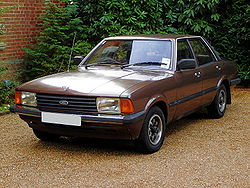
Production 1979-1982
production — see Mark IVAssembly Ford Dagenham assembly plant (Dagenham, England, United Kingdom)
Ford Lio Ho (Chungli City, Taoyuan, Taiwan)
Campbellfield, Victoria, Australia
Ulsan, South KoreaBody style 2-door saloon
4-door saloon
5-door estate
2-door convertible (conversion)
2-door pickup (P100)Engine 1.3L OHV "Kent" I4
1.6L OHC "Pinto" Straight-4
1.6L OHV "Kent" I4 (South Africa)
2.0L OHC "Pinto" I4
2.3L OHV "Cologne" V6
3.0L OHV "Essex" V6 (South Africa)
3.3L OHV I6 (Australia)
4.1L OHV I6 (Australia)Transmission 4-speed manual
3-speed automatic
3-speed manualThe Mark V was announced on 24 August 1979.[19] Officially it was known as "Cortina 80", although the Mark V tag was given to it immediately on release, by the press, insiders and the general public.
A large update on the Mark IV, it was really a step between a facelift and a rebody. The Mark V differentiated itself from the Mark IV by having revised headlights with larger turn indicators incorporated (which now showed to the side too), a wider slatted grille said to be more aerodynamically efficient, a flattened roof, more glass area, slimmer C-pillars with revised vent covers, larger, slatted tail lights (on saloon models) and upgraded trim.
Prices started at £3,475 for a basic 1.3-litre-engined model.[20]
Improvements were also made to the engine range, with slight improvements to both fuel economy and power output compared to the Mk.IV. For example, the 2.3V6 engine was given electronic ignition and a slight boost in power output to 116 bhp (87 kW; 118 PS), compared to the 108 bhp (81 kW; 109 PS) of the Mk.IV. Ford also claimed improved corrosion protection on Mk.V models, as a result more Mk.V's have survived, however corrosion was still quite a problem. Cars that were rust-proofed from new with treatments such as Waxoyl or Ziebart have tended to fare a lot better than untreated cars with only factory rust-proofing.
By contrast, the estate models combined the Mk IV's bodyshell (which was initially from the 1970 Ford Taunus) with Mk V front body pressings.
Variants included the Base, L, GL and Ghia variants (all available in both saloon and estate forms), together with Base and L spec 2-door sedan versions (this bodystyle was available up to Ghia V6 level on overseas markets). An optional "S" pack was also available for most models, For the final model year of 1982 this consisted of front and rear bumper overriders, sports driving lamps, an 'S' badge on the boot, tachometer, 4 spoke steering wheel, revised suspension settings, front gas shock absorbers,'Sports' gear lever knob, sports road wheels, 185/70 SR x 13 tyres and Fishnet Recaro sports seats (optional). Various "special editions" were announced, including the Calypso and Carousel. The final production model was the Crusader special edition which was available as a 1.3, 1.6 and 2.0 saloons or 1.6 and 2.0 estates. The Crusader was a final run-out model which buyers clamoured for in 1982, instead of buying a newly-introduced Sierra. It was the best-specified Cortina produced to date and 30,000 were sold, which also made it Ford's best-selling special edition model. Another much rarer special edition model was the Cortina Huntsman, of which 150 were produced. By this time, the Cortina was starting to feel the competition from a rejuvenated (and Opel influenced) Vauxhall, which with the 1981 release Cavalier J-Car, was starting to make inroads on the Cortina's traditional fleet market, largely helped by the front wheel drive benefits of weight and grip.
Up to and including 1981, the Cortina was the best selling car in Britain. Even during its final production year, 1982, the Cortina was Britain's second best selling car and most popular large family car. On the continent, the Taunus version was competing with more modern and practical designs like the Talbot Alpine, Volkswagen Passat and Opel Ascona, but the brand image of Ford's blue oval ensured the Cortina was a success in virtually every country where it was sold.
The very last Cortina – a silver Crusader – rolled off the Dagenham production line in 22 July 1982 on the launch of the ultramodern Sierra, though there were still a few leaving the forecourt as late as 1987, with one final unregistered Cortina GL leaving a Derbyshire dealership in 2005.[21] The last Cortina built remains in existence to this day, and is now in the ownership of the Ford Heritage Centre in Dagenham, Essex, not far from the factory where it was assembled.[22]
1982 was also the year in which the Cortina lost its title as Britain's best selling car, having held that position every year since 1972. It was still selling well though, and the number one position had been taken by another Ford product: the Escort.
Sales success
The Ford Cortina was a very popular car in Britain throughout its lifespan. In 1967, it interrupted the Austin/Morris 1100/1300s reign as Britain's best selling car. From 1972 to 1981, the Cortina enjoyed an unbroken run as Britain best selling car every year. Its key rivals in the 1960s were the Morris Oxford and Austin/Morris 1800, during the 1970s it was competing with the Vauxhall Cavalier, Austin Maxi and Morris Marina.[citation needed] At the end of its life it was facing stiff competition from the more advanced and practical second generation Vauxhall Cavalier, but was still more popular.[citation needed]
The final incarnation of the Cortina was Britain's best selling car for the 1980 and 1981 calendar years, and combined with Mark IV sales the Cortina also topped the sales charts for 1979. Even in 1982, when during its final year of production it was pushed off the top of the charts by the Ford Escort, the Cortina was still hugely popular with buyers.
The Cortina was also a very popular selling car in New Zealand throughout its production and continued to be sold new until 1984.[citation needed]
Although the last Cortina rolled off the production line in 1982, thousands of them remained in stock (with more than 11,000 being sold in 1983), and the final six examples didn't find homes until 1987.
As recently as the early 1990s, Cortinas were still a common sight on British roads, and in May 1992 The Times newspaper revealed that the Mark IV and Mark V models were still among the 10 most common cars on Britain's roads.[citation needed]
By 2000, however, the vast majority of them were no longer roadworthy. In August 2006, following a survey by Auto Express, it was identified as the second most scrapped car to be sold in Britain since 1976. Of the 1,065,682 Mark IV and Mark V Cortinas registered in the UK, just 2,010 were still on the road – fewer than one in 500. It was second only to the Morris Marina, which had ceased production two years before the Cortina and fared even worse with less than one in 1000 still registered.
A total of nearly 2,600,000 Cortinas were sold in Britain, and in March 2009 it was revealed that the Cortina was still the third most popular car ever sold there, despite having been out of production for nearly three decades.[23]
Racing and rallying
The Cortina also raced in rallies and Lotus did some sportier editions of the Cortina Mark I and Mark II referred to as the Lotus Cortina.
This car is, today, used for racing, because of its powerful cast iron engine. The car can have imported cylinder heads, with hydraulic valves, which give an enormous power boost.
The Cortina was also a popular car in UK Banger racing in the late '80s and throughout the 90's proving to be a competitive car and also lasting it out in Demolition Derbys.
Other cars using Cortina engines
The Kent engines used in the Cortina, being lightweight, reliable and inexpensive, were popular with several low-volume sports car manufacturers, including Morgan who used them in the 1962–81 4/4 (and continue to use Ford engines in most of their current models). The engines are also found in a number of British kit cars, and until recently was the basis of Formula Ford racing, until replaced by the "Zetec" engine.
The Kent engines were also used in several smaller Fords, most notably the Escort, lower end Capris and Fiesta.
Non-United Kingdom sales and manufacture
The Cortina was also sold in other right hand drive markets such as the Republic of Ireland where it was assembled locally, Australia, New Zealand, Indonesia, Malaysia, Singapore, Thailand, Malta and South Africa. Mark III Cortina estates were adopted as police cars in Hong Kong. The Cortina was also assembled in left hand drive in the Philippines, in South Korea (by Hyundai) and in Taiwan (by Ford Lio Ho) until the early 1980s.
The first two generations of the car were also sold through American Ford dealers in the 1960s. The Cortina competed fairly successfully there against most of the other small imports of its day, including GM's Opel Kadett, the Renault Dauphine, and the just-appearing Toyotas and Datsuns, although none of them approached the phenomenal success of the Volkswagen Beetle. The Cortina was withdrawn from the US market when Ford decided to produce a domestic small car in 1971, the Ford Pinto, though it continued in Canada until the end of the 1973 model year.
The third generation Cortina was also sold in some continental European markets, such as Scandinavia, alongside the Taunus. A small number were exported to Japan, with the rear of the bodyshell compressed to make it narrower — this was because cars in Japan were taxed on width, and having a narrower body enabled the Cortina to avoid being heavily taxed.
The Ford Cortina was also assembled in the Amsterdam Ford Factory from the launch in 1962 until 1975. Production was for the Dutch market, but also for export to non EU countries and even for export to the UK if the demand there was higher than the UK production capacity.
Australia
- Mark I
In Australia, the Mark I Ford Cortinas sold well, helped by some outstanding successes on the racetrack. The most notable performances were in the Armstrong 500 races at the Mount Panorama circuit, Bathurst, New South Wales where the Cortina GT was first across the line in 1963 and 1964 and the locally developed GT500 took the flag in 1965.
- Mark II
The Mark IIs continued the sales success, being offered in five different models - the 220, 240, 440, GT and the rare "L" luxury model which featured solid wood panelling on the dashboard and doors. The GT was readily identified by its bumperettes on the front and rear. Even rarer was the GTL with a much lightened flywheel but all the L features.
- TC
The Mark III was introduced into the Australian market in August 1971 as the TC Cortina.[24] and was offered in L, XL and XLE trim levels. It was initially available with 1600 cc "Cross-Flow" and 2000 cc SOHC four cylinder engines.[25] In September 1972 Ford Australia launched a six-cylinder version of the TC,[24] using the 200ci and 250ci in-line engines from the Australian Ford Falcon range. These engines had a blue rocker cover for the 200ci (3.3 litre) and a red rocker cover for the 250ci (4.1 litre). The 1600 cc engine option was discontinued in June 1973.[26]
The TC six-cylinder models had twin 5" headlights which distinguished them from the four-cylinder cars which had single 7" sealed beam headlights on each side. To hold the larger engines, the chassis had reinforced side rails and centre pillar, and a tubular crossmember support under the transmission. In addition, the firewall panels were shaped to accommodate the longer engines and wider bell housing, and were manufactured from thicker metal. This change was spread across the Cortina range so that the four cylinder models benefited too. But this was not enough to prevent the additional front mass of the larger engines causing roll steer, resulting in relatively unsophisticated handling by today's standards, especially on rough roads. Braking was also an issue under harsh conditions.
In 1973 to 1974, Ford Australia proposed a three-door coupé version of the Cortina, in order to compete with the upcoming Holden Torana hatchback. It would also be a local Capri replacement. This car would have used the Pinto tailgate and other parts from around the world (such as the longer 2-door Cortina doors). However, Ford rejected the idea, as a unique model, particularly a small coupé for Australia could not be justified on cost grounds.
- TD
The TD Cortina, released October 1974,[27] was offered in L, XL and XLE trim levels and could be identified by its plastic grille. Early TDs used single round headlights for both four- and six-cylinder models but rectangular units were part of the mid-life facelift of March 1976.[28] When fitted with the optional "Rallye" Pack, the later models featured round headlights and quartz halogen driving lights.[29]
Both the TC and TD six cylinder models were immediately recognized over the four-cylinder versions by the raised 'power bulge' in the center of the bonnet. It was widely believed that this was to allow clearance of the air filter. However it was a purely a cosmetic change as a four-cylinder bonnet will fit over a six-cylinder Cortina's engine bay.[original research?] Basic transmission for the six-cylinder model was originally a three-speed manual floor shift, with a four-speed Borg-Warner single rail transmission available, taken straight from the Falcon GT. Also available was a Borg-Warner M35 three-speed automatic across all models. From 1976 the six cylinder engines featured a revised crossflow cylinder head, keeping in line with the Falcon.
- TE
The Mark IV was released in Australia in 1977 as the TE Cortina. It had trim levels of L, GL and Ghia with a few other short run variants, such as the 'S' pack. The TE featured the 2.0L Pinto motor and 4 speed manual gearboxes as used in earlier models, and the 200ci (3.3 Litre) and 250ci (4.1 Litre) OHV sixes with a crossflow cylinder head. Late in the TE's life, in 1980, the 6-cylinder heads were changed to an Alloy design, mirroring the engine development of the Ford Falcon XD range, The external door handles were also used from the XD Falcon range although the Falcon handles were black, the Cortina's chrome. The front windscreen and passenger, drivers windows as well as a slightly revised dash were also carried over from the Australian TD Cortina.
Aside from the engines, the Australian TE had minor exterior differences to the Cortina models sold elsewhere. Bumpers were the most noticeable differences, as the TE had larger chromed steel bumpers with rubber coated ends and additional indicators in the front wings. The whole TE range had a higher centre pressing in the bonnet to accommodate the six cylinder engines air cleaner. This change is not obvious unless you have the two different bonnets side by side.
There was a proposal in 1975 by Ford Australia to simply facelift the TD (Mark III) series Cortina for 1977, rather than introduce the Mark IV. A prototype facelift was made, however Ford instead went with a re-engineered Mark IV (née the German Ford Taunus).
- TF
The Mark V was released in Australia in 1980 as the TF Cortina and was offered in L, GL and Ghia variants and with an optional S-Pack also available. The TF had minor exterior differences to the Cortina models sold elsewhere with rubber RIM moulded bumpers being the most noticeable. Another example was that the TF's front numberplate was mounted below the front bumper, further distinguishing it from its European Mark V counterparts. Like the TE, the whole TF range had a higher centre pressing in the bonnet to accommodate the six cylinder engines air cleaner.
In the late 1970s, the Cortina wagons were built in Renault's local Heidelberg factory in Melbourne, (now closed), as Ford Australia's own factories did not have the capacity. For the last year of Australian Cortina production, 1981, a Ghia wagon was produced, although this was also listed in the September 1980 factory brochure.
Despite the TF Cortina introducing worthwhile improvements in ride, handling, noise reduction and fuel consumption, the Cortina generally was seen by the motoring press as outdated, and buyers generally preferred the rival products — in marked contrast to New Zealand where the Cortina was a highly regarded success.
Ford Australia, however, found enough customers to last to the end of the model's life. In 1982 it was replaced initially by the smaller Ford Meteor (a rebadged Mazda 323 sedan) and then the Ford Telstar saloon / hatchback range in 1983.
New Zealand
The New Zealand Cortina range generally followed that of Britain. Overall CKD assembly ran from 1962 to 1983, at Ford's Lower Hutt (Seaview) plant.
The Mark IV Cortina range, introduced into local assembly early in 1977, was very similar to that offered in the UK - a main specification difference however was the use of metric instrumentation, and that a 2-door sedan was not offered. Engine sizes of 1.6 and 2.0 litres were available. The 2.0 L was a very popular fleet vehicle and the transport of thousands of sales reps in New Zealand over the years.
Additionally there were limited imports of Australian Mark IV Cortinas, equipped with both 2.0 four-cylinder engines which featured more emissions control equipment than the UK-sourced cars, and the Falcon's 4.1 L six-cylinder engines.
The Mark V range was introduced early in 1980, a range that featured 1.6 base, 2.0 L, 2.0 GL, 2.0 Ghia, 2.3 V6 Ghia, and wagon variants for the 1.6 base and 2.0 L. In 1982 the 2.0 GL model was discontinued and replaced with a 2.0 S (Sport) model, and unlike in the UK, it was a model in its own right. A 2.0 "van" was also introduced — essentially a Cortina estate without rear seats, aimed towards fleet buyers.
All 2.0 litre models had the option of automatic transmission, and with the 2.3 V6, it was the only transmission offered.
A unique option, offered under guarantee by a dealership, South Auckland Ford, was a turbocharger.
The Ghia models were similarly equipped to UK models, but only the 2.3 V6 models featured imported Ford alloy wheels. Ford 'Rostyle' steel rims were fitted to all 2.0 GL, Ghia and S models, optionally on the other models. New Zealand Ghia models however did not feature a steel sliding sunroof (fitted as standard on UK Ghia models), although some models did feature an aftermarket sunroof.
Unlike Australia, the Cortina was always a popular car in New Zealand, and was missed by many when it ceased production in mid-1983, notably after Ford New Zealand had scoured the globe for surplus assembly kits, a number of which came from Cork in Ireland. Station wagons (estate models) remained available until 1984. The Cortina range was finally replaced by the 1983 Ford Telstar range and the 1984 Ford Sierra station wagon.
Compared with Britain and many other countries where the Cortina was originally exported, in New Zealand it has a far superior survival rate due to the climate being far drier and more favorable to the preservation of rust-free classic cars. It is not uncommon to see examples in everyday use especially New Zealand's rural areas, and obtaining spare parts to keep them on the roads is yet to become a significant problem.
Portugal
- P100 pickup
From 1971, the Cortina formed the basis of the Ford P100 pick-up truck, which was produced for Europe in Portugal and other continents in South Africa. Ironically, the MK5 Cortina based P100 was launched in 1982, the year that the standard Cortina was being replaced by the Sierra. However, it remained a popular choice with pick-up truck buyers until the Sierra-based P100 was launched in 1988; this version lasted until the end of Sierra production in early 1993.
South Africa
In South Africa, the Cortina range included V6 "Essex"-engined variants, in both 2.5L and 3.0L forms.
From July 1971, a locally designed pick-up truck version (known in Afrikaans as a "bakkie") was also offered, and this remained in production after the Cortina was replaced by the Sierra.
The Cortina pickup was exported to the UK, in a lengthened wheelbase form, as the Ford p100 until 1988, when Ford divested from South Africa, and a European built pick-up truck version of the Sierra was introduced in its place.
The Mk V model range, introduced in 1980 for the South African market included: 1.3L (1980–1982), 1.6L GL (1980–1983), 2.0 GL, Ghia, (1980–1984), 3.0 XR6 (1980–1983), 1.6L Estate (1980–1983), 2.0 GL Estate (1980–1983), 3.0 GLS (1980–1984), 1.6 One-Tonner (1980–1985), 3.0 One-Tonner (1980–1985).
The XR6 was a sports version which used the Essex v6 and featured body aerofoils and sport seats.
In 1981 a version called the XR6 Intercepter was released as a homologation special made to compete in production car racing. They featured triple Weber dcnf carburetors, aggressive camshaft, tubular exhaust manifold, suspension revisions and wider Ronal 13inch wheels. They produced 118kW and were only availabe in red. 200 were produced.
Later on a special edition XR6 TF was released to celebrate 'Team Fords' racing success with the XR6. They were essentially XR6s in exterior and interior Team Ford colours, which were blue and white.
In 1983 a special version was created by Simpson Ford to appease the demand for an Intercepter-like Cortina and was sold through Ford dealerships countrywide. It was called the XR6 X-ocet and featured a Holley carbureter, aggressive camshaft and tuned exhaust. They came in red with a white lower quarter and did 0-100 km/h in 8.5 seconds with a top speed of 195 km/h.
South African Mk V models differed slightly from UK models with different wheels, bumpers and interior trim.
References
- ^ The Private Life of the Ford Cortina, British Film Institute. Accessed 2009-07-19. Archived 2009-07-21.
- ^ Cortina Auto-Bobbing FordHeritage YouTube channel. Retrieved 2010-06-06.
- ^ a b c d e "Used Car Test: 1962 Ford Cortina". Autocar. 130 (nbr 3804): 22–23. date 9 January 1969.
- ^ a b Culshaw; Horrobin (1974). Complete Catalogue of British Cars. London: Macmillan. ISBN 0-333-16689-2.
- ^ http://news.google.com/newspapers?id=jd9AAAAAIBAJ&sjid=C6cMAAAAIBAJ&pg=3466,3119184&dq=new-ford-cortina&hl=en
- ^ "Ford Cortina Mk1 UK Domain". Fordcortina.co.uk. 1998-05-16. http://www.fordcortina.co.uk/. Retrieved 2011-07-22.
- ^ a b c d e f g "The Fourth Cortina". Autocar: page 12–16. date 2 October 1976.
- ^ http://news.google.com/newspapers?id=XeE9AAAAIBAJ&sjid=TEgMAAAAIBAJ&pg=3117,2780714&dq=new-ford-cortina&hl=en
- ^ a b "Cortina - new right through". Motor. nbr 3360: 152–158. date 22 October 1968.
- ^ "Cortina - new right through". Motor: 152–158. date 22 October 1966.
- ^ a b "Ford Cortina Estate Car". Autocar. 126 (nbr3705): 20–21, 32. 15 February 1967.
- ^ a b c d e f g "Road test: Ford Cortina 1300XL". Motor: 12–16. 12 February 1972.
- ^ "Know your car: Ford Cortina". Autocar: between pages 25 & 26. date 16 November 1967.
- ^ http://news.google.com/newspapers?id=0Oo9AAAAIBAJ&sjid=p0gMAAAAIBAJ&pg=3658,4554073&dq=new-ford-cortina&hl=en
- ^ "World wide: Ford and their market gap". Autocar. 134 (nbr3928): 3. 8 July 1971.
- ^ "Autotest Ford Cortina 1600 XL". Autocar. 138 (nbr 4004): 16–21. 22 February 1973.
- ^ http://news.google.com/newspapers?id=jN49AAAAIBAJ&sjid=M0gMAAAAIBAJ&pg=3153,6066976&dq=new-cortina&hl=en
- ^ a b c "Qual der Wahl: Taunus Kaufberatung". Auto Motor u. Sport. Heft 17 1976: Seite 45–52. date 18 August 1976.
- ^ http://news.google.com/newspapers?id=He1AAAAAIBAJ&sjid=WqcMAAAAIBAJ&pg=4508,4707373&dq=new-cortina&hl=en
- ^ "FORD Cortina ‘80 | Car Specs | Octane". Classicandperformancecar.com. http://www.classicandperformancecar.com/front_website/octane_interact/carspecs.php?see=4030. Retrieved 2011-07-22.
- ^ Unregistered Cortina, 2005
- ^ "Hammond's trip down memory lane - Norfolk Motoring News, Road Tests and more". EDP24. http://www.edp24.co.uk/content/edp24/lifestyle/motoring/story.aspx?brand=EDPOnline&category=motoringNews&tBrand=EDPOnline&tCategory=motoringNews&itemid=NOED03%20Sep%202010%2010%3A26%3A32%3A877. Retrieved 2010-09-10.
- ^ "icLiverpool - Recession-proof wise-buys revealed". Icliverpool.icnetwork.co.uk. 2009-03-17. http://icliverpool.icnetwork.co.uk/motors/advice/tm_headline=recession-proof-wise-buys-revealed&method=full&objectid=23171460&siteid=63127-name_page.html. Retrieved 2010-07-27.
- ^ a b The Macquarie Dictionary of Motoring, 1986, page 168
- ^ Ford Cortina TC sales brochure, June 1971, page 11
- ^ The Red Book Used Car Price Guide, November 1985, page 38
- ^ Green Book Price & Model Guide, July–August 1983, page 30
- ^ Green Book Price & Model Guide, July–August 1983, page 30 & 31
- ^ Ford Cortina sales brochure, Ford Motor Company of Australia, August 1976
External links
Ford car timeline, European market, 1960s–1980s — next » Type 1960s 1970s 1980s 0 1 2 3 4 5 6 7 8 9 0 1 2 3 4 5 6 7 8 9 0 1 2 3 4 5 Supermini Fiesta I Fiesta II Small family car Anglia 105E / Super Anglia 123E Escort I Escort II Escort III Large family car Consul II Cortina I Cortina II Cortina III / Taunus TC Cortina IV / Taunus III Cortina V / Taunus III Sierra Taunus G13 Taunus P4 Taunus P6 Classic Corsair Executive car Taunus P3 Taunus P5 Taunus P7 Taunus P7.2 Consul (Granada) Granada I Granada II Zephyr II Zephyr 4/6 III Zephyr 4/6 IV Zodiac II Zodiac III Zodiac IV Coupé Consul Capri Capri Mk1 Capri Mk2 Capri Mk3 Ford of Europe Divisions and
subsidiariesCurrentDefunctFacilities CurrentAutomobile Craiova · Bridgend Engine · Cologne Body & Assembly · Dagenham Plant · Dunton Technical Centre · Genk Body & Assembly · Lommel Proving Grounds · Merkenich Technical Centre · Otosan Assembly · Saarlouis Body & Assembly · Southampton Body & Assembly · Valencia Plant · Vsevolozhsk AssemblyFormerPassenger cars CurrentPastCommercial vehicles MinibusesTrucks (defunct)VansCurrentPastCategories:- Ford of Europe vehicles
- Mid-size cars
- Rear wheel drive vehicles
- Rally cars
- Vehicles introduced in 1962
Wikimedia Foundation. 2010.




